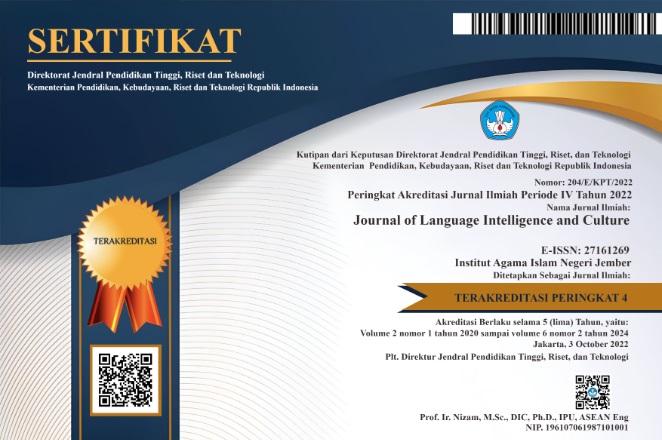Exploring Codes Mixing of Arabic Language at Islamic Boarding School: A Study on Students’ Daily Communication
DOI:
https://doi.org/10.35719/jlic.v6i2.141Keywords:
Arabic practice, code-mixing, daily communicationAbstract
This study examines code-mixing phenomena in the oral Arabic communication of students at An-Nur Tangkit Islamic boarding school in Indonesia. Given the relatively recent introduction of Arabic as a foreign language, students often incorporate Indonesian elements into their speech. Through qualitative field research involving observation and interviews, this study investigates the specific forms of code-mixing employed by students and teachers. The analysis reveals three primary language elements in code-mixing: individual words, phrases, and clauses. These findings contribute to a deeper understanding of the linguistic practices and challenges faced by learners of Arabic in Indonesian educational settings.
References
Al-Ali, M. (2012). The Impact of Code Mixing on the Relevance of Islamic Teachings in Modern Contexts. Journal of Islamic Education, 12(2), 1-12.
Al-Khateeb, A. (2015). The Role of Code Mixing in Preserving Local Dialects in Islamic Boarding Schools. Journal of Islamic Studies, 25(1), 1-18.
Al-Khateeb, A. (2015). Balancing Code Mixing with Standard Arabic in Islamic Boarding Schools. Journal of Islamic Education, 15(1), 1-10.
Al-Mansour, A. (2017). The Challenge of Maintaining Linguistic Purity in the Face of Code Mixing in Islamic Boarding Schools. Journal of Arabic Language and Literature, 8(2), 1-12.
Al-Masri, M. (2018). Code Mixing in Arabic: A Study of its Prevalence and Functions in Modern Arabic Discourse. Journal of Arabic Linguistics, 10(2), 1-15.
Al-Mutawa, N. A. (2017). Code-mixing in English-Arabic bilingual discourse: A sociolinguistic perspective. International Journal of Linguistics, 9(2), 1-19.
Al-Sayed, A. (2019). Simplifying Religious Texts through Code Mixing: A Case Study from an Islamic Boarding School. Journal of Religious Education, 17(1), 1-15.
Al-Sayed, A. (2019). Integrating Code Mixing into the Curriculum of Islamic Boarding Schools: Challenges and Opportunities. Journal of Educational Research and Development, 12(2), 1-12.
Al-Tamimi, T. (2018). Enhancing Student Engagement through Code Mixing in Islamic Boarding Schools. Journal of Educational Research and Development, 10(1), 1-10.
Al-Qasim, J. (2016). Linguistic Interference in Code Mixing: A Study from an Islamic Boarding School. Journal of Linguistic Research, 6(1), 1-9.
Aldzakhiroh, N., Nopriansyah, B., Nasution, A. H., & Fikri, S. (2024). “Bahasa, Bias Gender Dan Identitasnya Pada Buku Al’arabiyah Li Al’indunisiyyin.” Al Mi’yar: Jurnal Ilmiah Pembelajaran Bahasa Arab Dan Kebahasaaraban 7 (1). https://doi.org/http://dx.doi.org/10.35931/am.v7i1.3044.
Devianty, R. (2017). Bahasa Sebagai Cermin Kebudayaan. Tarbiyah, Jurnal 24 (2). https://doi.org/http://dx.doi.org/10.30829/tar.v24i2.167.
El-Hassan, S. (2003). Code Switching and Language Mixing in Arabic: A Sociolinguistic Perspective. International Journal of the Sociology of Language, 164, 35-54.
Gardner, R. C. (2001). Attitudes, motivation, and second language learning. Annual Review of Applied Linguistics, 1(1), 123-142.
Grosjean, F. (1998). Bilingual language processing. Psychological Review, 105(3), 626-650.
Herman, H., & Laode, A. (2022). “Pendidikan Islam Anak Suku Bajo: Penelitian Lapangan Pada Suku Bajo.” Jurnal Obsesi?: Jurnal Pendidikan Anak Usia Dini 6 (4). https://doi.org/10.31004/obsesi.v6i4.2266.
Heryani, H. (2022). Kedwibahasaan Pada Masyarakat Tutur Di Kota Cirebon. Jurnal Education and Development, 10 (2): 429–33.
Meisel, J. M. (2000). The role of language awareness in second language learning. Language Awareness, 9(3), 177-191.
Nopriansyah, B., Nasution, A. H., & Aldzakhirohm N., (2024). Fenomena Alih Kode Bahasa Serawai Kabupaten Kaur Dan Kabupaten Bengkulu Selatan Ke Dalam Bahasa Indonesia. LINGUISTIK?: Jurnal Bahasa & Sastra 9 (1). http://jurnal.um-tapsel.ac.id/index.php/Linguistik/article/view/14560.
Nugroho, M. (2020). Vitalitas Bahasa Saleman Di Negeri Saleman. Ranah: Jurnal, 9: 260–71. https://doi.org/https://doi.org/10.26499/rnh.v9i2.2938.
Pandiangan, F. S., & Rosadi, M. (2023). Analisis Dialek Dalam Bentuk Bahasa Percakapan Dalam Film ‘Imperfect’ Karya Meira Anastasia. Journal of Educational Research and Humaniora (JERH), 1 (3): 47–58. https://doi.org/10.51178/jerh.v1i3.1546.
Rana, A. Z. (2022). Generasi Muda Dan Masa Depan Bahasa Daerah Sebagai Bahasa Ibu. Retrieved from: https://badanbahasa.kemdikbud.go.id/artikel-detail/4304/generasi-muda-menjaga-eksistensi-bahasa-daerah
Rini, D. (2018). Diksi Dan Gaya Bahasa Dalam Media Sosial Instagram. Jurnal Widyaloka Ikip Widya Darma, 5 (3): 261–78.
Thalib, M. A. (2022). Pelatihan Teknik Pengumpulan Data Dalam Metode Kualitatif Untuk Riset Akuntansi Budaya. Seandanan: Jurnal Pengabdian Pada Masyarakat, 2 (1). https://doi.org/10.23960/seandanan.v2i1.29.
Wulandari, P. A., Setiawan, T., & Fadilla, A. R. (2023). Alih Kode Dan Campur Kode Dalam Channel Youtube Londokampung Dalam Interaksi Pasar. Jurnal Genre (Bahasa, Sastra, Dan Pembelajarannya) 5 (1): 56–65. https://doi.org/10.26555/jg.v5i1.7385.
Downloads
Published
How to Cite
Issue
Section
License
Copyright (c) 2024 Beri Nopriansyah, Inqiado Al-farisi, Gita Fitri Ramadhani

This work is licensed under a Creative Commons Attribution-ShareAlike 4.0 International License.













